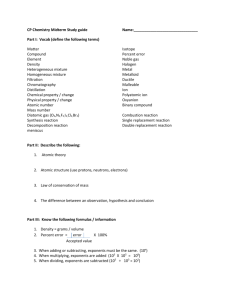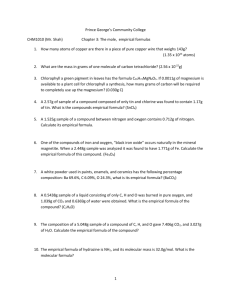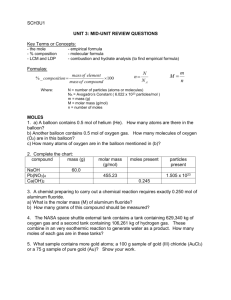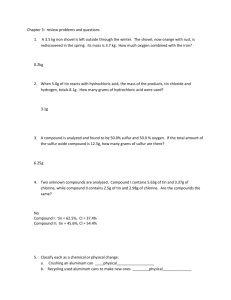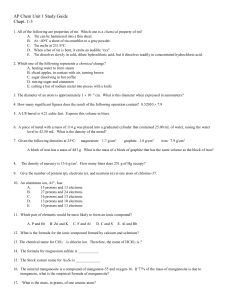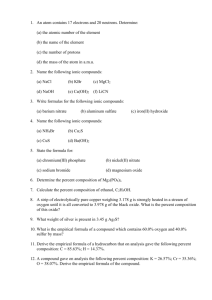Empirical Formula
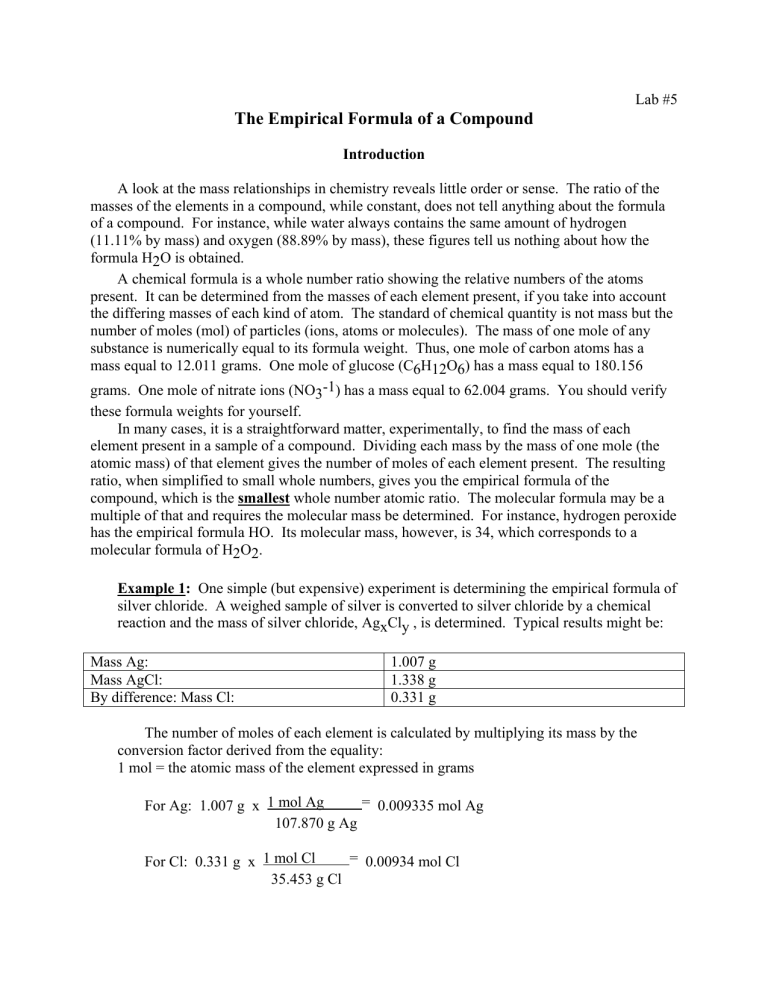
Lab #5
The Empirical Formula of a Compound
Introduction
A look at the mass relationships in chemistry reveals little order or sense. The ratio of the masses of the elements in a compound, while constant, does not tell anything about the formula of a compound. For instance, while water always contains the same amount of hydrogen
(11.11% by mass) and oxygen (88.89% by mass), these figures tell us nothing about how the formula H2O is obtained.
A chemical formula is a whole number ratio showing the relative numbers of the atoms present. It can be determined from the masses of each element present, if you take into account the differing masses of each kind of atom. The standard of chemical quantity is not mass but the number of moles (mol) of particles (ions, atoms or molecules). The mass of one mole of any substance is numerically equal to its formula weight. Thus, one mole of carbon atoms has a mass equal to 12.011 grams. One mole of glucose (C6H12O6) has a mass equal to 180.156 grams. One mole of nitrate ions (NO3-1) has a mass equal to 62.004 grams. You should verify these formula weights for yourself.
In many cases, it is a straightforward matter, experimentally, to find the mass of each element present in a sample of a compound. Dividing each mass by the mass of one mole (the atomic mass) of that element gives the number of moles of each element present. The resulting ratio, when simplified to small whole numbers, gives you the empirical formula of the compound, which is the smallest whole number atomic ratio. The molecular formula may be a multiple of that and requires the molecular mass be determined. For instance, hydrogen peroxide has the empirical formula HO. Its molecular mass, however, is 34, which corresponds to a molecular formula of H2O2.
Example 1: One simple (but expensive) experiment is determining the empirical formula of silver chloride. A weighed sample of silver is converted to silver chloride by a chemical reaction and the mass of silver chloride, AgxCly , is determined. Typical results might be:
Mass Ag: 1.007 g
Mass AgCl:
By difference: Mass Cl:
1.338 g
0.331 g
The number of moles of each element is calculated by multiplying its mass by the conversion factor derived from the equality:
1 mol = the atomic mass of the element expressed in grams
For Ag: 1.007 g x 1 mol Ag = 0.009335 mol Ag
107.870 g Ag
For Cl: 0.331 g x 1 mol Cl = 0.00934 mol Cl
Cl
The numbers of moles of each element present in silver chloride are essentially the same, so the empirical formula must be AgCl (meaning Ag and Cl are present in a 1 : 1 ratio). Since this is an ionic compound, there are no molecules present and the question of a molecular formula does not arise.
Example 2: In some cases, you may be supplied with the per cent composition of a compound from an analytical laboratory. This requires an extra computational step to find the empirical formula. For instance, an organic compound is reported as consisting of 53.38% carbon, 11.18% hydrogen and 35.53% oxygen. For simplicity, assume you have 100.00 grams of the compound. Then you can work with 53.38 g C, 11.18 g H and 35.53 g O. First find the moles of each element in the 100 g.
Carbon: 53.38 g x 1 mol C = 4.444 mol C
12.011 g C
Hydrogen: 11.18 g x 1 mol H = 11.09 mol H
1.008 g H
Oxygen: 35.53 g x 1 mol O = 2.221 mol O
16.00 g O
These can be converted to whole number ratios by dividing each by the smallest number present (2.221):
Carbon: 4.444 = 2.001 mol C = 2 mol C
2.221
2.221
Oxygen: 2.221 = 1.000 mol O = 1 mol O
2.221
Thus the empirical formula of the compound is C2H5O. This compound is found to have a molecular weight of 45.062, thus its molecular formula is the same as the empirical formula. Verify this for yourself!
In some cases, the last step will result in simple decimal fractions instead of whole numbers. These are converted into whole numbers by multiplying the decimal numbers by the smallest whole number that will successfully convert all the values to whole numbers.
Thus, a ratio of N1.0O1.5 would be changed to N2O3 by multiplying by 2 and a formula ratio of C1.00H1.33O1.00 would be changed to C3H4O3 by multiplying by 3.
Since per cent composition is the preferred method of reporting analytical results, you should know how to calculate it from analytical data. The fraction of each element present is the mass of that element in the sample, divided by the total mass of the sample.
Thus for the 1.338 g of silver chloride in example 1:
% Ag = 1.007 g Ag x 100 = 75.26%
1.338 g silver chloride
% Cl = 0.331 g Cl x 100 = 24.7%
1.338 g silver chloride
In this experiment, you will make two valid determinations of the empirical formula of an oxide of tin, which is a compound composed of only tin and oxygen. You will take a known mass of tin and react it with nitric acid, the source of oxygen, to obtain tin oxide.
The other products of the reaction, nitrogen dioxide and water, will be removed by heating, leaving only tin oxide as the isolated product. The difference in mass between the original tin and the tin oxide is the mass of oxygen in the compound.
The unbalanced equation for the reaction is:
Sn(s) + HNO3 (aq) Æ SnxOy (s) + H2O(g) + NO2 (g)
Procedure:
To save time, work on two determinations simultaneously, using two beakers, letting one cool while you work on the other. Use beakers of two different sizes (100, 150 or 250 mL) for your two trials.
Be sure the beakers are clean and dry . Weigh each beaker to 0.001 grams, if possible.
Obtain two pieces of tin sheet metal, approximately 1.5 inches square. If the tin surfaces are not shiny, buff them with steel wool and wipe clean with a paper towel. Follow the procedure below for each of your trials in this experiment.
Cut one of the tin sheets into small pieces and place in one of the beakers and weigh.
The mass of the tin should be about 1 gram. Be sure that the mass is not greater than 1.1 g or less than 0.75 g. Obtain a 10 - 15 mL supply of concentrated HNO3 in a small beaker.
IN THE HOOD slowly add 3 mL of concentrated HNO3 to the tin and gently swirl until all the evolution of brown NO2 gas has stopped. Add another 3 mL of the acid and swirl until brown gas evolution has stopped. Then add the acid dropwise with an eyedropper, continuing to swirl, until no NO2 is evolved. There should now be a white precipitate
visible and no tin pieces visible. Use the minimum amount of acid to convert the metal to a white solid.
Heat the mixture on a hot plate, in the hood, at a setting of 2 with intermittent swirling to complete the reaction and drive off the water and nitrogen dioxide. Cover the beaker with a watch glass to avoid loss of sample due to spattering. The watch glass should be weighed first and then reweighed at the end of the experiment. Any added weight should be added to the weight of tin oxide produced.
CAUTION: Do not get nitric acid on your hands - wash immediately with running water and report to your instructor.
Turn the hot plate to high heat and continue heating with occasional swirling until the sample appears dry. The product should be white at this point. If there are still pieces of metal visible, allow the sample to cool to room temperature and add HNO3 dropwise, while swirling, until no more brown gas is evolved. Then repeat the heating process. If all the tin has been converted to a white solid, transfer the beaker to a wire gauze and heat with a hot flame for 5 minutes. This can be done at your bench. If brown NO2 gas is evolved at this point, quickly return the beaker to the hot plate and reheat.
CAUTION: NO2 is toxic and irritating. Avoid inhaling these fumes.
Return the beaker to the flame and heat for 5 minutes over the Bunsen burner. Allow the beaker to cool and obtain the mass of beaker plus the tin oxide. Reheat the beaker and contents for another 5 minutes over the Bunsen burner, allow to cool, and weigh. The two masses should be within 0.005 grams of each other. If a large difference is found, reheat for another 5 minutes. This is called heating to constant weight and insures that all water has been driven off. The tin oxide may have a tan or yellow color at this time. This will not affect your results. Clean the beaker and discard the tin oxide in the heavy metal waste container.
DATA SHEET
Name ____________________________________________ Section ____________
Empirical Formula
Trial Number
1 2
Lab #5
Mass of beaker
Mass of beaker + tin
__________ __________
__________ __________
Mass of tin __________ __________
Mass of watch glass at start __________
Mass of beaker + tin oxide
(first heating)
Mass of beaker + tin oxide
(second heating)
Mass of beaker + tin oxide
(third heating, if necessary)
__________
__________
__________
__________
__________
__________
Mass of watch glass at end __________
Mass of tin oxide __________ __________
Mass of oxygen __________ __________
Results and Calculations
1. How would the loss of tin oxide from the beaker , due to spattering, etc. affect the empirical formula of your tin oxide? Explain your answer. (2 points)
Lab #5
2. (6 points) Calculate the per cent composition by mass of the tin oxide for both trials.
3. Calculate the empirical formula of tin oxide for both trials. Show all your work clearly for full credit. (6 points)
Lab #5
PRESTUDY
Name _________________________________________ Section _____________
The Empirical Formula of a Compound
1.(1 point) A compound has the molecular formula Na
2
S
2
O
4
. What is its empirical formula?
2.(1 point) What is the mass of 0.986 moles of Na
2
S
2
O
4
?
3.(1 point) How many moles are there in 95.7 grams of Na
2
S
2
O
4
?
4.(1 point) A compound has an empirical formula of CH approximately 183.0. What is its molecular formula?
2
O and a gram-formula-weight of
5.(4 points) What is the empirical formula of a compound that consists of 54.10% Ca,
2.70% H and 43.20% O? Show your work.
6.(2 points) What is the per cent composition of Na
2
S
2
O
4
? Show your work.
